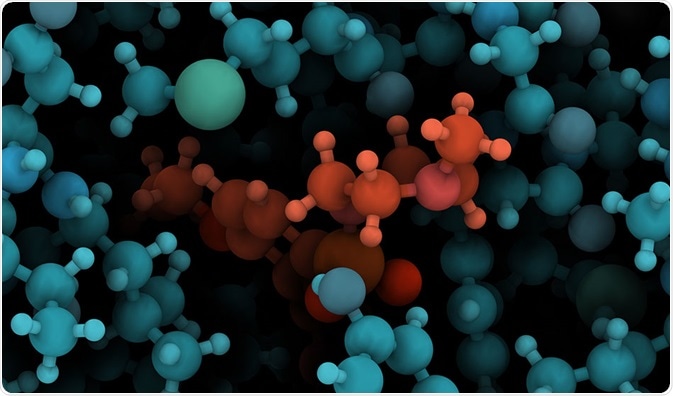By Jeyashree Sundaram, MBA
Cyclic adenosine 3,5-monophosphate (cAMP) is a cyclic nucleotide that serves as a vital second messenger in several signaling pathways.

Credit: molekuul_be/Shutterstock
Multiple cellular functions such as cell growth and specialization, protein expression, and gene transcription are regulated by cAMP.
During the progression of disease, complicated sequences of events such as cytokine secretion, resistance to toxins, and the production of pathological events are regulated by the complex intracellular pathways within a cell.
A balance between the activity of enzymes, including cyclic nucleotide phosphodiesterase (PDE) and adenylyl cyclase (AC) is required to regulate intracellular cAMP levels.
Numerous genes encoding these two enzymes vary in their regulatory mechanisms and expression patterns, creating cell types as well as particular stimulating responses.
Factors of cAMP
AC is activated by a type of G-alpha, which in turn induces the conversion of adenosine triphosphate (ATP) into cAMP. The stimulated adenylyl cyclase can produce numerous cAMP molecules to intensify the signal.
The major effect of cAMP is to bind with and activate protein kinase A (PKA), also called the cAMP-dependent kinase. Subsequently, PKA phosphorylates the particular protein to elicit cellular reactions.
Phosphodiesterases may break down the cAMP, sometimes limiting the signal length. For regulating the transcription of genes, phosphorylation of a transcription factor cAMP response-element binding-protein (CREB) is more important.
By modifying the phosphorylation in CERB, transcription of various kinds of targeted genes is activated through extracellular signals developing various physiological functions.
PDEs can induce hydrolysis of intracellular cAMP molecules and the cAMP levels are, therefore, indirectly increased by PDE inactivation. Several conditions and diseases, such as myocardial atrophy, inflammation, cancer, depression, and asynodia are connected to the pathways of the second messenger, which includes the cyclic AMP signaling pathway.
Inhibitors and activators
Several physiological processes are regulated by many activated factors and the cAMP signal pathway. Research on cAMP has proved that interruption of the cAMP signaling pathway can take part in the treatment of various human diseases.
Forskolin is an inducer that is extensively used in the formation of cAMP. The activation of adenylyl cyclase assists forskolin to increase intracellular cAMP concentrations.
Several studies have proven that forskolin is used to raise the expression of inflammatory factors stimulated by lipopolysaccharide (LPS), which are regulated through the cAMP-dependent pathway.
The effect of forskolin is similar to that of the cholera toxin (CTX). Both are used to increase the levels of cAMP and also the inducible nitric oxide synthase (iNOS) bu LPS. Additionally, dibutyryl-cAMP, an analog of cAMP was identified to be able to mimic the agents activating cAMP.
-
PKA activators and inhibitors
The process of the cAMP signaling pathway depends upon PKA. Generally, H89 is utilized as PKA inhibitor. H89 is a potent, cell permeable, and selective inhibitor of PKA, dependent on cAMP.
Investigations on H89 have reported that it can block prostaglandin E2 (PGE2), LPS, phosphoceramide analog stimulated cellular secretion of nitric oxide, cyclooxygenase 2 (COX2), and other inflammatory factors, including interleukin 6.
Conversely, H89 can obstruct the mitogen-activated protein kinase (MAPK) pathway by preventing the expression of MAPK phosphatase-1 (MKP-1) at the protein level and CREB-mediated mRNA, thus reducing the LPS-induced inflammatory reaction.
H89 prevents the production of cholangiocarcinoma cells that is encouraged by PGE2 via triggering the cAMP-PKA-CREB pathway.
Bt2cAMP, also called dibutyryl-cAMP, activates the PKA directly and increases the expression of LPS-induced iNOS, which leads to stimulation of the nuclear factor-kB (NF-kB).
PDE is the single distinct intracellular hydrolase enzyme for cAMP. The intracellular concentration of cAMP is controlled by induction of guanyl cyclases and ACs which react to extracellular signaling. PDE inhibitors increase the intracellular cAMP level and also have an influence on different types of cells.
PDE inhibitors have the capacity to treat various types of disease conditions and are therefore recommended for the treatment of renal failure and nephritis.
The most widely used PDE4 inhibitor is rolipram, which has been demonstrated to considerably increase the levels of cAMP, ameliorate intelligence and memory, depression, improve the activity of arginine enzyme, and control various types of inflammation.
Reducing cAMP hydrolysis whilst inhibiting PDE4 induces vomiting. Due to this fact, rolipram is not often used for PDE4 subtypes.
Another generally used inhibitor is 3-isobutyl-1-meth-ylxanthine derived from S-adenosylmethionine (SAM). SAM performs like an anti-inflammatory drug and serves as an effective inhibitor of PDE4B in the treatment of diseases such as chronic inflammation.
The final PDE inhibitor used is Pentoxifylline. Pentoxifylline raises intracellular cAMP, possesses antifibrotic and immunosuppressive activity, and enhances hemodynamics.
Pyrazolopyridines are also inhibitors of PDE4, and have the potential treat chronic emphysema and bronchitis. In addition, the inhibitor cilostazol not only contains an anti-inflammatory influence but also prevents platelet accumulation that causes vasodilation.
Further Reading